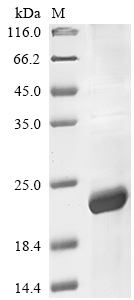Recombinant Human Interleukin-31 (IL31) is produced in E. coli and contains the complete mature protein sequence from amino acids 24 to 164. The protein includes an N-terminal 10xHis-tag and a C-terminal Myc-tag, which help with purification and detection processes. SDS-PAGE analysis shows the protein achieves greater than 85% purity, which appears to provide consistent results in experimental work.
Interleukin-31 is a cytokine that seems to play an important role in immune response regulation. It likely participates in pathways affecting cellular signaling and inflammation, though the exact mechanisms may vary depending on the cellular context. IL31 has drawn considerable attention from researchers studying immune system functions and inflammatory processes. Understanding this protein could advance our knowledge in immunology and related disciplines.
Potential Applications
Note: The applications listed below are based on what we know about this protein's biological functions, published research, and experience from experts in the field. However, we haven't fully tested all of these applications ourselves yet. We'd recommend running some preliminary tests first to make sure they work for your specific research goals.
Human IL31 is a four-helix bundle cytokine that requires precise disulfide bond formation and proper tertiary structure for its biological activity through binding to the IL31 receptor complex (composed of IL31RA and OSMRβ). The E. coli expression system cannot perform the necessary eukaryotic post-translational modifications, particularly correct disulfide bonding, which is critical for IL31's native conformation. The dual N-terminal His-tag and C-terminal Myc-tag may sterically interfere with the protein's folding and receptor-binding interfaces. Therefore, this recombinant IL31 is highly unlikely to achieve correct folding or functional activity.
1. Antibody Development and Validation Studies
This recombinant IL31 serves as an excellent immunogen for generating antibodies against linear epitopes of human IL31. The full-length mature sequence ensures comprehensive epitope coverage. The dual tags facilitate purification and provide additional epitopes for screening. However, antibodies may not efficiently recognize conformational epitopes on the native, properly folded IL31 found in biological systems.
2. Biochemical Characterization and Stability Studies
This is the essential first step to assess the protein's physical properties. Techniques like size-exclusion chromatography can determine oligomeric state, while circular dichroism can analyze secondary structure content and thermal stability. These studies provide critical quality control data but characterize a misfolded protein, not native IL31.
3. ELISA Development and Immunoassay Optimization
This protein is well-suited as a standard for quantitative ELISA to detect immunoreactive IL31 levels. The assay depends on antibody binding to linear epitopes, so the protein's folding state is less critical. The dual tags enable flexible immobilization and detection strategies for reliable standard curve generation.
Final Recommendation & Action Plan
The E. coli expression system is fundamentally unsuitable for producing a functional version of this complex cytokine, limiting its applications to non-functional uses. The protein can be reliably used for Application 1 (Antibody Development) and Application 3 (as an ELISA standard). Application 2 (Biochemical Characterization) should be prioritized to understand the protein's physical properties. Any interaction data would be biologically irrelevant without validation using naa tively folded protein from eukaryotic systems. For functional IL31 studies, the only valid approach is to use the protein expressed in a eukaryotic system (e.g., mammalian cells) that can provide proper disulfide bond formation and folding.






